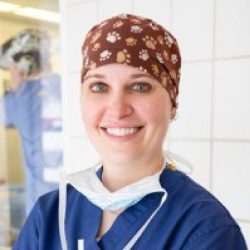If you ask a class of second-graders what they want to be when they grow up, many will tell you about their dreams of being a veterinarian. Rarely will one have a specialty picked out, but Dr. Ashley VanderBroek had specific goals in mind.

“As soon as I realized that I wanted to be a vet, I decided that I wanted to be an equine surgeon and work at Michigan State when I grew up,” she says. As a high school student, she never visited campus or even applied to any other university because she was determined to earn an undergraduate degree and attend veterinary school at Michigan State University.
VanderBroek completed these goals, following them up with an internship at the University of Georgia, a residency at the University of Pennsylvania, and becoming a large animal diplomate of the American College of Veterinary Surgeons. She returned to the MSU College of Veterinary Medicine in 2020 as an assistant professor of large animal surgery.
In the clinic
Her childhood self would be delighted to learn that her workdays (and nights) are often spent operating on horses, as well as other large animals. “About seventy to eighty percent of the large animal cases we see at the Veterinary Medical Center are horses, but I operate on the majority of the goats, sheep, and pigs that come in,” she says. “Initially, I liked the variety of working on animals that ranged from less than 2 pounds to over 2000 pounds, but I have since grown quite fond of the non-equine species.”
As faculty, VanderBroek is heavily involved with research, teaching, and clinics, but the biggest portion of her job is working with students in the clinic, which suits her well. “I’ve always been at academic institutions, so I’m very accustomed to having students associated with each patient,” she says. “I keep students very close to the process; working up the case, doing the diagnostics, participating in surgery; all of it. I enjoy research, but my passion is working with the patients and students.”

In the depths of research
VanderBroek’s current research looks at adhesions in the tendons of horses.
“Tendon injuries are fairly common in horses, and when the tendons heal, sometimes they heal with scar tissue in the tendon sheath,” she explains. “Tendons should normally glide within the tendon sheath as the horse moves, but when they form scar tissue, they get stuck in one place, and don’t glide as they should.”
Along with a resident, VanderBroek is conducting research to see if certain medications can prevent formation of adhesions.
In the classroom—as a student
As both a graduate of the College’s DVM program and a current faculty member, VanderBroek has a unique perspective on the curriculum over the years. The curriculum she helps to teach today has been redesigned from the one she studied as a student, and targets a different style of learning.
“I’m a very detail-focused person (being a surgeon, that’s not very surprising),” she says. “Right now, students concentrate on one topic for three weeks at a time, like the musculoskeletal, respiratory, or digestive system. I think it’s cool that they can keep their brain on that topic for an extended period of time, delving deep into the intricacies of each topic.”
For more about Dr. VanderBroek’s work, see case studies she has written: The Case of the Missing Testicle—MSU Equine Surgeons are on the Hunt! and MSU Large Animal Veterinarians Make Rare Diagnosis, Help Pig Breathe Normally Again.
Puzzle Me This
VanderBroek says that her students and colleagues might be surprised about one of her biggest nonclinical passions.
“I love jigsaw puzzles, to the point where I actually do not allow myself to have any puzzles in my house because once I start one, I do not leave until it’s finished,” she says. “When I retire, I will be the jigsaw puzzle queen.”
Jigsaw puzzles were a fun part of her student experience, as well. “When I was a student here, there was a jigsaw puzzle in the oncology atrium. I’d sit and work on it while waiting for my appointments to arrive.”


